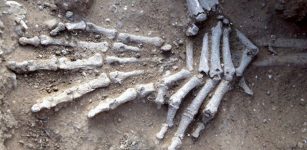Largest In Europe Underground Church Of Saint-Jean of Aubeterre Built By 12th Century Benedictine Monks
A. Sutherland - AncientPages.com - The 12th century Benedictine monks created the subterranean Church of Saint-Jean of Aubeterre that we can admire today. It is the largest underground church in Europe.
The skilled craftsmen were not in possession of our modern tools, but their creation is formidable, indeed.
The massive church was built in caves that already existed, along with a baptismal pool, carved in the form of a Greek cross and located in the center of the nave that dates from the 4th century.

Hewn from solid limestone during the XII Century by Benedictine monks, from an upper plateau to the outside ground level. The monks utilised natural caverties and fault lines eroded by underground streams to help them in their tasks. Credits: Fiendishly Fre
The church is 27 meters long, 16 meters wide, and 20 meters high. It is important to understand that this was not just a giant cave that was converted into a church. It is actually carved in the form of a contemporary church, with the great columns, niches and the vaulted nave.
The unique monolithic structure is almost completely carved out of the limestone and it stands on it, too.
This was an gigantic achievement and must have somehow answered an equally enormous need in ancient times.

The church itself, and its crypt, were hidden for centuries by a rock fall, and only rediscovered in the 1950′s.
The original purpose of this underground structure was to preserve religious artifacts in a reliquary (“a shrine of Holy relics”) and in a number of pits. The inspiration came most probably from the design of the Sepulchre in Jerusalem, discovered during the First Crusade at the end of the 11th century.
However, another source of inspiration of the ancient skilled craftsmen may originate in stories about the impressive rock hewn temples and underground cities of the Cappadocia in modern day Turkey.
The Church of Saint-Jean of Aubeterre itself, and its crypt, were hidden for centuries by a rock fall. They were rediscovered in the 1950′s.
The sheer scale of this edifice with its nave 20 meters in height, its surrounding gallery, and the hundreds of stone sarcophagi in the necropolis, testify to the importance of the church as a religious and sacred place.

Pre-Christian necropolis with eighty stone coffins with additional older layers of older coffins.via via lucis
The pre-Christian necropolis contains eighty stone coffins and features several layers of coffins. when one layer was filled and covered with soil, the next layer was filled up. The necropolis was hidden from sight until January 1961.
It was discovered accidentally when a truck was passing on adjacent street, which began to collapse, revealing the necropolis below.
Pilgrims often visit the subterrenean Church of Saint-Jean, a true natural wonder surrounded by aura of magic and mystery.
Written by – A. Sutherland - AncientPages.com Senior Staff Writer
Copyright © AncientPages.com All rights reserved. This material may not be published, broadcast, rewritten or redistributed in whole or part without the express written permission of AncientPages.com
Expand for referencesMore From Ancient Pages
-
 Nihansan And Bricriu: Unpredictable Tricksters Who Fool Others And Are Fooled Themselves
Featured Stories | May 11, 2024
Nihansan And Bricriu: Unpredictable Tricksters Who Fool Others And Are Fooled Themselves
Featured Stories | May 11, 2024 -
 10 Most Bizarre Forms Of Ancient Taxes: Surprising And Funny
Featured Stories | Nov 21, 2016
10 Most Bizarre Forms Of Ancient Taxes: Surprising And Funny
Featured Stories | Nov 21, 2016 -
 Pergamon – One Of ‘Seven Churches Of Asia’ With Great Library And Sophisticated Water Supply System
Civilizations | Jul 25, 2018
Pergamon – One Of ‘Seven Churches Of Asia’ With Great Library And Sophisticated Water Supply System
Civilizations | Jul 25, 2018 -
 Why Is The Three Golden Balls Symbol For A Pawn Shop Connected To The Medici Family?
Ancient History Facts | Feb 12, 2019
Why Is The Three Golden Balls Symbol For A Pawn Shop Connected To The Medici Family?
Ancient History Facts | Feb 12, 2019 -
 230,000-Year-Old Human Remains Discovered In Eastern Africa – Rewrite Ancient History
Archaeology | Jan 14, 2022
230,000-Year-Old Human Remains Discovered In Eastern Africa – Rewrite Ancient History
Archaeology | Jan 14, 2022 -
 ‘Venus of Willendorf’: New Theory On ‘Venus’ Figurines – Proposed
Artifacts | Dec 1, 2020
‘Venus of Willendorf’: New Theory On ‘Venus’ Figurines – Proposed
Artifacts | Dec 1, 2020 -
 Was Aztec And Mixtec Turquoise Mined In the American Southwest?
Archaeology | Jun 15, 2018
Was Aztec And Mixtec Turquoise Mined In the American Southwest?
Archaeology | Jun 15, 2018 -
 Pharaoh Ay – A Man With A Hidden Agenda Or A Victim Of Unfortunate Circumstances?
Featured Stories | Feb 5, 2019
Pharaoh Ay – A Man With A Hidden Agenda Or A Victim Of Unfortunate Circumstances?
Featured Stories | Feb 5, 2019 -
 Anglo-Saxon Warlord’s Grave: Archaeologists And Metal-Detectorists Work Together
Archaeology | Oct 7, 2020
Anglo-Saxon Warlord’s Grave: Archaeologists And Metal-Detectorists Work Together
Archaeology | Oct 7, 2020 -
 What 12 Ancient Skeletons Discovered In A Mysterious Tomb In Petra Could Tell Us About The Ancient City
Featured Stories | Oct 25, 2024
What 12 Ancient Skeletons Discovered In A Mysterious Tomb In Petra Could Tell Us About The Ancient City
Featured Stories | Oct 25, 2024 -
 Story Of Uncle Sam – Symbol Of The United States Government
Ancient Symbols | Apr 24, 2017
Story Of Uncle Sam – Symbol Of The United States Government
Ancient Symbols | Apr 24, 2017 -
 On This Day In History: Chaldean Account Of The Deluge Translated And Presented For The First Time – On Dec 3, 1872
News | Dec 3, 2016
On This Day In History: Chaldean Account Of The Deluge Translated And Presented For The First Time – On Dec 3, 1872
News | Dec 3, 2016 -
 Startling 3,000-Year-Old Gold Bowl Decorated With A Sun Motif Discovered Is A Truly Unique Artifact
Archaeology | Oct 17, 2021
Startling 3,000-Year-Old Gold Bowl Decorated With A Sun Motif Discovered Is A Truly Unique Artifact
Archaeology | Oct 17, 2021 -
 10 Divine Weapons Of The Gods
Featured Stories | Jul 28, 2015
10 Divine Weapons Of The Gods
Featured Stories | Jul 28, 2015 -
 4,500-Year-Old Skeletons Found In SW China
Archaeology | Apr 19, 2016
4,500-Year-Old Skeletons Found In SW China
Archaeology | Apr 19, 2016 -
 World’s Oldest And Largest Maya Structure Revealed By LIDAR
Archaeology | Jun 9, 2020
World’s Oldest And Largest Maya Structure Revealed By LIDAR
Archaeology | Jun 9, 2020 -
 Unexpected Discovery Of Rare Ancient Roman Carved Wooden Figure In Buckinghamshire
Archaeology | Jun 11, 2022
Unexpected Discovery Of Rare Ancient Roman Carved Wooden Figure In Buckinghamshire
Archaeology | Jun 11, 2022 -
 200 Tons Of Silver Hidden From The Romans On The Shores Of The River Lahn
Archaeology | Feb 23, 2023
200 Tons Of Silver Hidden From The Romans On The Shores Of The River Lahn
Archaeology | Feb 23, 2023 -
 On This Day In History: Aviator Amelia Earhart Was The First Woman To Cross The Atlantic By Air – On June 18, 1928
News | Jun 18, 2016
On This Day In History: Aviator Amelia Earhart Was The First Woman To Cross The Atlantic By Air – On June 18, 1928
News | Jun 18, 2016 -
 Flying Objects Were Present In Ancient Skies
Featured Stories | May 9, 2014
Flying Objects Were Present In Ancient Skies
Featured Stories | May 9, 2014

